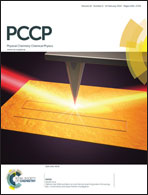Topological reaction sites – very strong chalcogen bonds
Abstract
The analysis of interactions in complexes of S(CN)2, Se(CN)2, SFCl and SeFCl with F− and Cl− anions is performed here. The sulphur and selenium atoms act in these complexes as Lewis acid centres interacting with fluorine and chlorine anions. The arrangement of sub-units in complexes is in agreement with the σ-hole concept; particularly it is a result of contacts between positive and negative electrostatic potential sites. The interactions in complexes analyzed may be classified as very strong charge assisted chalcogen bonds and they possess numerous characteristics typical for covalent bonds. Even in the case of complexes of SFCl and SeFCl, i.e. SFCl2− and SeFCl2−, the trivalency of the chalcogen atom is observed. The calculations were carried out at the MP2(full)/aug-cc-pVTZ level of approximation, the analyses were performed with the use of the Natural Bond Orbital (NBO) method, the Quantum Theory of ‘Atoms in Molecules’ (QTAIM) and the Electron Localization Function (ELF) approach. The results obtained by these methods are in agreement giving the consistent picture of the complexes' configurations and their electron charge distribution. The QTAIM and ELF approaches allow us to predict for S(CN)2, Se(CN)2, SFCl and SeFCl molecules the directions of nucleophilic attack. They are in line with the prediction based on the σ-hole concept. The Symmetry Adapted Perturbation Theory (SAPT) approach was also applied.


 Please wait while we load your content...
Please wait while we load your content...